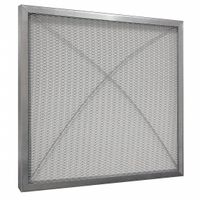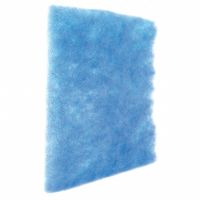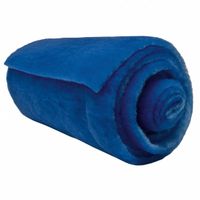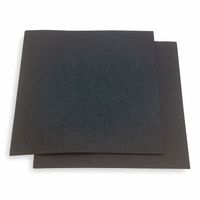Call +(254) 703 030 000 / 751 483 999 / 721 704 777
- Home
- Hvac And Refrigeration
- Air Filters
- Air Filter Pads And Rolls
.....Read More
Frequently Asked Questions
What are air filter pads and rolls used for?
Air filter pads and rolls are essential components in various air filtration systems, designed to improve air quality by removing particulates and contaminants from the air. They are used in a wide range of applications, including residential, commercial, and industrial settings.
1. **HVAC Systems**: In heating, ventilation, and air conditioning (HVAC) systems, air filter pads and rolls are used to trap dust, pollen, mold spores, and other airborne particles. This helps maintain clean air circulation, enhances system efficiency, and prolongs the lifespan of HVAC equipment by preventing dust buildup.
2. **Industrial Applications**: In industrial environments, air filter pads and rolls are crucial for maintaining air quality and protecting machinery. They are used in paint booths, manufacturing plants, and other facilities to capture overspray, dust, and fumes, ensuring a safe and clean working environment.
3. **Cleanrooms**: In cleanrooms, where air purity is critical, air filter pads and rolls help maintain stringent air quality standards by filtering out microscopic particles. This is vital in industries like pharmaceuticals, electronics, and biotechnology, where even minor contamination can affect product quality.
4. **Residential Use**: In homes, air filter pads and rolls are used in air purifiers and HVAC systems to improve indoor air quality. They help reduce allergens, pet dander, and other pollutants, providing a healthier living environment.
5. **Custom Applications**: Air filter pads and rolls can be cut to size for custom applications, making them versatile for various filtration needs. They are available in different materials and thicknesses to suit specific requirements, such as high-efficiency particulate air (HEPA) filters for more demanding filtration tasks.
Overall, air filter pads and rolls are vital for maintaining air quality, protecting equipment, and ensuring the health and safety of occupants in various environments.
How do I choose the right air filter pad or roll for my system?
To choose the right air filter pad or roll for your system, consider the following factors:
1. **Filter Type**: Determine the type of filter your system requires. Common types include fiberglass, polyester, and pleated filters. Each has different efficiency levels and applications.
2. **Size**: Measure the dimensions of your current filter or the space where the filter will be installed. Ensure the new filter matches these dimensions for a proper fit.
3. **MERV Rating**: The Minimum Efficiency Reporting Value (MERV) rating indicates the filter's ability to capture particles. Higher MERV ratings (8-13) capture smaller particles but may restrict airflow. Choose a rating that balances air quality needs and system compatibility.
4. **Airflow Requirements**: Ensure the filter allows adequate airflow for your system. High-efficiency filters can restrict airflow, potentially overworking the system. Check the system's specifications for recommended airflow rates.
5. **Material**: Select a material that suits your environment. Fiberglass is economical but less efficient, while polyester offers better durability and efficiency. Pleated filters provide higher efficiency and longer life.
6. **Application**: Consider the environment where the filter will be used. For residential use, a MERV 8-11 is typically sufficient. For commercial or industrial settings, higher MERV ratings may be necessary.
7. **Maintenance**: Evaluate how often the filter needs replacement. Higher efficiency filters may require more frequent changes. Consider ease of replacement and maintenance costs.
8. **Budget**: Balance cost with performance. Higher efficiency filters are more expensive but may offer better air quality and longer life.
9. **Brand and Quality**: Choose reputable brands known for quality and reliability. Read reviews and seek recommendations if necessary.
10. **Compatibility**: Ensure the filter is compatible with your HVAC system to avoid performance issues.
By considering these factors, you can select an air filter pad or roll that meets your system's needs and maintains optimal air quality.
How often should air filter pads and rolls be replaced?
Air filter pads and rolls should generally be replaced every 1 to 3 months, depending on several factors. The frequency of replacement depends on the type of filter, the environment in which it is used, and the specific needs of the HVAC system.
For residential settings, filters in homes with pets, smokers, or allergy sufferers may require more frequent changes, possibly every month. In contrast, homes without these factors might extend the replacement period to every 2 to 3 months.
In commercial or industrial environments, where air quality demands are higher, filters might need to be replaced more frequently, sometimes even monthly, to ensure optimal air quality and system efficiency.
Additionally, the type of filter material and its MERV (Minimum Efficiency Reporting Value) rating can influence replacement frequency. Higher MERV-rated filters, which capture smaller particles, may need more frequent changes due to quicker accumulation of debris.
Regular inspection of the filter is crucial. If the filter appears dirty or clogged before the scheduled replacement time, it should be changed immediately to maintain air quality and system performance.
Ultimately, following the manufacturer's recommendations and considering the specific conditions of the environment will help determine the optimal replacement schedule.
What materials are air filter pads and rolls made from?
Air filter pads and rolls are made from a variety of materials, each chosen for specific filtration needs and applications. Common materials include:
1. **Fiberglass**: Widely used for its cost-effectiveness and efficiency in capturing large particles. Fiberglass filters are composed of fine glass fibers arranged in a random pattern, providing a high dust-holding capacity.
2. **Polyester**: Known for its durability and resistance to moisture, polyester is often used in environments where humidity is a concern. It can be woven or non-woven, offering flexibility in design and application.
3. **Foam**: Polyurethane foam is used for its ability to capture both large and small particles. It is often used in applications requiring washable and reusable filters.
4. **Cotton**: Natural cotton fibers are sometimes used in air filters for their ability to trap dust and other particulates. Cotton filters are often combined with synthetic materials to enhance performance.
5. **Activated Carbon**: Used primarily for odor control and gas absorption, activated carbon filters are made by treating carbon with oxygen to open up millions of tiny pores between the carbon atoms. This material is often combined with other filter media to provide both particulate and odor filtration.
6. **Synthetic Fibers**: These include materials like polypropylene and polyester blends, which are engineered to provide high efficiency and durability. They are often used in HEPA filters for their ability to capture very fine particles.
7. **Metal Mesh**: Typically made from aluminum or galvanized steel, metal mesh filters are used in industrial applications for their strength and ability to withstand high temperatures.
Each material offers unique properties that make it suitable for specific filtration tasks, from residential HVAC systems to industrial air purification.
Can air filter pads and rolls be cut to size?
Yes, air filter pads and rolls can be cut to size. These materials are designed to be versatile and customizable to fit various HVAC systems, air purifiers, or other filtration needs. Typically made from materials like fiberglass, polyester, or foam, they are manufactured in large sheets or rolls, allowing users to cut them to the specific dimensions required for their particular application.
Cutting air filter pads and rolls to size is a straightforward process. You will need a pair of sharp scissors or a utility knife to ensure clean edges and precise cuts. It's important to measure the dimensions of the filter frame or housing accurately before cutting to ensure a snug fit, which is crucial for optimal filtration performance and efficiency. A well-fitted filter prevents air bypass, where unfiltered air could circulate through the system, reducing the effectiveness of the filtration.
When cutting, it's advisable to wear gloves and a mask to protect against any loose fibers or particles that may be released. After cutting, the filter should be placed securely within the frame or housing, ensuring there are no gaps or loose edges.
Custom-cut air filter pads and rolls are particularly useful in non-standard or unique applications where pre-made filters are not available. They offer flexibility and can be a cost-effective solution for maintaining air quality in various environments, from residential to industrial settings. Regular maintenance and replacement of these custom filters are essential to ensure they continue to function effectively, as clogged or dirty filters can impede airflow and reduce system efficiency.
How do air filter pads and rolls improve air quality?
Air filter pads and rolls enhance air quality by capturing and removing airborne contaminants, thereby ensuring cleaner and healthier indoor environments. These filters are typically made from materials like fiberglass, polyester, or synthetic fibers, which are designed to trap particles of varying sizes.
Firstly, air filter pads and rolls act as a physical barrier, capturing dust, pollen, mold spores, and other particulate matter as air passes through them. This is crucial in reducing allergens and irritants that can cause respiratory issues, particularly for individuals with allergies or asthma.
Secondly, these filters can also capture larger particles such as pet dander and lint, which contribute to indoor air pollution. By removing these particles, air filter pads and rolls help maintain a cleaner environment, reducing the need for frequent cleaning and dusting.
Moreover, some air filter pads and rolls are treated with antimicrobial agents, which inhibit the growth of bacteria, mold, and mildew on the filter media. This not only extends the life of the filter but also prevents the recirculation of harmful microorganisms into the indoor air.
Additionally, by improving air quality, these filters contribute to the efficient operation of HVAC systems. Clean filters ensure optimal airflow, reducing the strain on the system and enhancing energy efficiency. This not only lowers energy costs but also prolongs the lifespan of the HVAC equipment.
In summary, air filter pads and rolls improve air quality by effectively trapping airborne particles, reducing allergens, and preventing microbial growth. They support healthier indoor environments and contribute to the efficient functioning of HVAC systems, ultimately promoting better respiratory health and comfort.
Where can I buy air filter pads and rolls?
You can purchase air filter pads and rolls from a variety of sources, including:
1. **Home Improvement Stores**: Major chains like Home Depot, Lowe’s, and Menards offer a wide selection of air filter pads and rolls. These stores often have knowledgeable staff who can help you choose the right product for your needs.
2. **Online Retailers**: Websites like Amazon, eBay, and Walmart.com provide a vast array of options. Online shopping allows you to compare prices, read customer reviews, and have products delivered directly to your door.
3. **HVAC Supply Stores**: Specialized HVAC supply stores, such as Johnstone Supply or Grainger, offer professional-grade air filter materials. These stores cater to both professionals and DIY enthusiasts.
4. **Manufacturer Websites**: Brands like Filtrete, Honeywell, and Nordic Pure sell directly through their websites. Purchasing directly from the manufacturer can ensure authenticity and access to the latest products.
5. **Local Hardware Stores**: Smaller, independent hardware stores often carry air filter materials. These stores can provide personalized service and may offer products not found in larger chains.
6. **Warehouse Clubs**: Membership-based stores like Costco and Sam’s Club sometimes stock air filter pads and rolls in bulk, which can be cost-effective for frequent replacements.
7. **Specialty Online Stores**: Websites dedicated to air quality and HVAC products, such as DiscountFilters.com or AirFilters.com, offer a wide range of options and expert advice.
8. **Automotive Stores**: If you are looking for air filters for vehicles, stores like AutoZone, Advance Auto Parts, and O'Reilly Auto Parts carry a variety of options.
9. **Local HVAC Contractors**: Some HVAC service providers sell air filter materials directly to consumers, often as part of a maintenance package.
Consider factors like size, material, and MERV rating when selecting air filter pads and rolls to ensure they meet your specific air quality needs.



